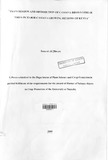| dc.description.abstract | Cassava brown streak virus disease (CBSD) is a viral disease that remained endemic for a long period of time in Eastern Africa exhibiting a delimited distribution along the coastal low lands. However, today there are reports of CBSD out break and re-emergence in areas where it was absent or commonly observed as endemic. Despite the fact that CBSD has been confined along the coastal cassava growing districts for a long period, there is no information on its spread and occurrence in other cassava growing regions in Kenya. Its vectors of transmission have not been clearly studied in details in Kenya, although there is a report suggesting a whitefly species Bemisia tabaci to be transmitting the cassava brown streak virus.
A survey to determine the prevalence, incidence and severity of CBSD in relation to whitefly populations was conducted in selected cassava growing areas of Western, Nyanza, Eastern and Central provinces of Kenya. An additional survey was conducted to determine the occurrence, distribution and host range of Spiralling whitefly Aleurodicus dispersus in relation to CBSD incidence in major cassava growing districts of coastal Kenya. The adult whitefly populations were directly counted on 5 representative shoots per cassava plant. Cassava leaf samples from farmers' fields in the main cassava-growing districts were collected and subjected to reverse transcription-polymerase chain reaction (RT- PCR) for detection of cassava brown streak virus (CBSV).
Green house trial on the transmission of CBSV was also carried out using two susceptible farmer preferred cassava varieties and cassava pests within cages. Arthropod pest species (mites and insects) including cassava green mite Mononychellus tanqjoa (Bondar), cassava mealy bug Phenacoccus manihoti (Matile-Ferrero), spiraling whitefly Aleurodicus
dispersus (Russels) and the whitefly Bemisia labaci (Gennadius) were used in CBSV transmission experiments. Adults of the pests were given access to CBSV by introducing them in cages with CBSV-infected cassava plants for 48-h access acquisition feeding period (AAP). This was followed by transferring them to recipient virus free CBSD- susccptible cassava plants of MM96/5280 and MM96/4466 clones in net cages for access inoculation feeding period of 48-hours (IAP). Successful transmission was confirmed by detection of CBSV in leaf samples by RT-PCR.
CBSD incidence was highest in western Kenya (46-100%) but not detected in samples from Central and Eastern provinces. The results report and confirm the presence of CBSD for the first time in Nyanza and Western provinces indicating that the disease is no longer confined along coastal lowlands of Kenya. There was a significant and positive correlation (r=+0.6977, p<0.001) between number of adult whitefly vector, Bemisia iabaci. The emergence of spiraling whitefly having a wide host range and a significant and positive correlation (r=+0.5189, p<0.001) with CBSD incidence in coastal Kenya is reported for the first time.
Bemisia tabaci transmitted CBSV (40.7%) whereas Mononychellus tanajoa (Bondar), cassava mealybug Phenacoccus manihoti (Matile-Ferrero), did not transmit the virus at all. However, Spiraling whitefly also showed ability to transmit CBSV at low rate of 25.9%. These results and high incidence of cassava brown streak disease (CBSD) in the field significantly coinciding with increases in whitefly numbers; further support the evidence that B. tabaci is a vector of CBSV and a first report of the role of spiraling whitefly in spread of CBSD.
The results of the investigations on ability of the insects collected from the infected cassava field to acquire and inoculate the virus help us in understanding the role of the white fly species in the development and spread of CBSD in field conditions. The implication of this important finding is that host-plant resistance to white fly may be considered as a possible method of dual control for CBSD (Hillocks et al., 2005). All these findings help in understanding the epidemiology of CBSD hence an input in development of disease management strategies. | en_US |


